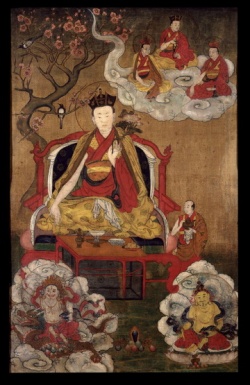Pule Si
Pule si, built by the Qianlong emperor between 1766–67, was the 6th of 12 outer temples built at Chengde. Although called the Eight Outer Temples in Chinese (Wai ba miao) the twelve were built in the following order (the first two by Kangxi, and the rest by Qianlong): Puren si, Pushan si, Puning si, Puyou si, Anyuan miao, Pule si, Putuozongcheng miao, Guang’an si, Shuxiang si, Luohan tang, Xumifushou miao, and Anguo si. These outer temples flanked the eastern and northern edges of the imperial summer resort, the Bishu shanzhuang. The innovative and deliberate reinterpretations of architectural styles and landscapes from Chinese and Inner Asian sources at Chengde have been likened to a rational political tool used to further modern conceptions of state formation. Pule Si was part of a larger scenic landscape, with 36 landscape vistas, that illustrated a series of perspectives that the Kangxi and Qianlong emperors deliberately displayed to their Chinese bureaucrats and Inner Asian nobles. Each layer of the landscape was created to resonate with only select audiences of the emperor’s empire, with the emperor as the unifying center able to mediate all the landscape layers. These scenes were displayed to show the dynamism of landscape as an aesthetic medium that was then circulated through the empire via multilingual publications such as the imperially-sponsored Album of Imperial Poems.
Pule si, resembling Beijing’s Temple of Heaven (and possibly suggesting a link to the altar of Heaven in the old Manchu capital, Mukden) and described as a stupa and mandala, was built for the western Mongols coming for the yearly tribute. Its name links it to two other outer temples. Together, Pule si, Anyuan miao, and Puning si contain the three characters, le, an, ning, that signify the three ways to nirvana. Unlike other outer temples that face south according to Qing imperial tradition, Pule si (and like Anyuan miao) is oriented toward the west, recalling the orientation of older Tibetan temples such as the Jokhang in Lhasa and Samye.
Pule si is situated south of Anyuan miao and aligned with the Bangchui rock formation to the east, which connects it in a straight line, through the center of the temple, to the imperial residence. The main temple of Pule si is a triple terrace. The lowest level, no longer extant, was a surrounding gallery. The upper terrace is a wooden, Indian-style mandala containing a statue of Samvara and covered by a circular golden ceiling decorated with an imperial dragon. The link between Pule si and the Qianlong emperor is further clarified by the imperial inscription that mentions the role of Lcang skya Rol pa’i rdo rje in constructing the temple. Lcang skya had given the Qianlong emperor the Samvara initiation. Thus the construction of Pule si with its Samvara mandala has been said to symbolize the lama-patron relationship between Lcang skya and the Qianlong emperor, while its construction on the eve of the western Mongols’ tributary visit can possibly be interpreted as a symbol of their new link with the empire.
Readings of Pule si must take into account its context within the larger imperial landscape production at Chengde. As such, it was part of an aesthetic, consumerist, and thus modern, instrument of unification for the producer, the emperor, as well as an instrument of alienation for the consumer, the imperial subjects.
Sources:
Philippe Forêt. 2000. Mapping Chengde: The Qing landscape enterprise. Honolulu: University of Hawai'i. pp. 49-53, 116-138.
Anne Chayet. 2004. Architectural Wonderland: An Empire of Fictions. In James Millward, et al. eds. New Qing Imperial History: The Making of Inner Asian Empire at Qing Chengde. pp. 33-52.
Entry by Eveline S. Yang 4/17/07
